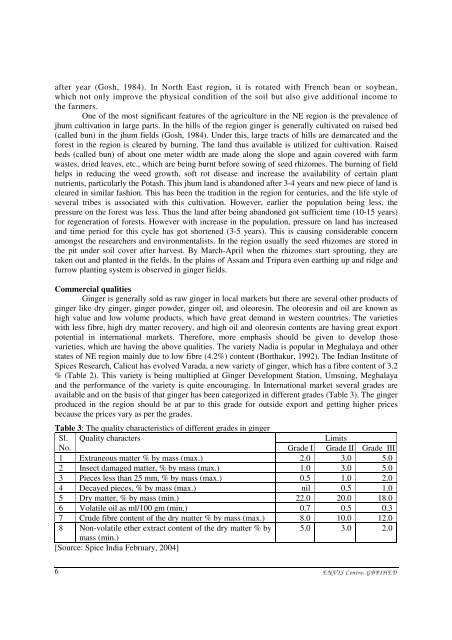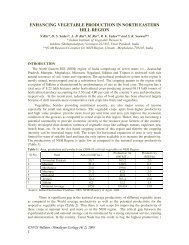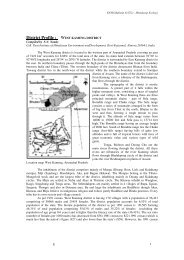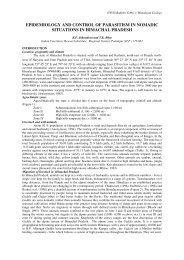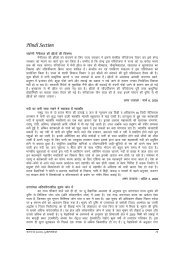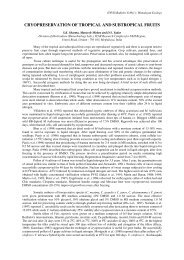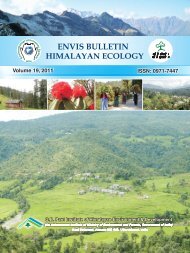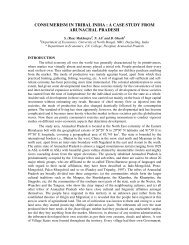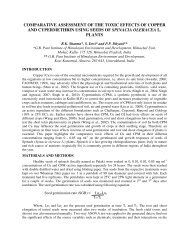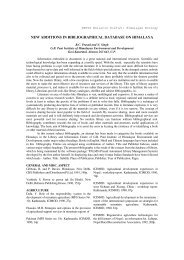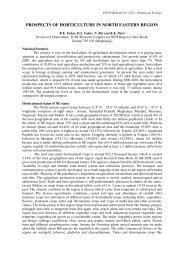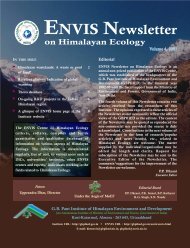after year (Gosh, 1984). In North East regi<strong>on</strong>, it is rotated with French bean or soybean,which not <strong>on</strong>ly improve the physical c<strong>on</strong>diti<strong>on</strong> of the soil but also give additi<strong>on</strong>al income tothe farmers.One of the most significant features of the agriculture in the NE regi<strong>on</strong> is the prevalence ofjhum cultivati<strong>on</strong> in large parts. In the hills of the regi<strong>on</strong> ginger is generally cultivated <strong>on</strong> raised bed(called bun) in the jhum fields (Gosh, 1984). Under this, large tracts of hills are demarcated and theforest in the regi<strong>on</strong> is cleared by burning. The land thus available is utilized for cultivati<strong>on</strong>. Raisedbeds (called bun) of about <strong>on</strong>e meter width are made al<strong>on</strong>g the slope and again covered with farmwastes, dried leaves, etc., which are being burnt before sowing of seed rhizomes. The burning of fieldhelps in reducing the weed growth, soft rot disease and increase the availability of certain plantnutrients, particularly the Potash. This jhum land is aband<strong>on</strong>ed after 3-4 years and new piece of land iscleared in similar fashi<strong>on</strong>. This has been the traditi<strong>on</strong> in the regi<strong>on</strong> for centuries, and the life style ofseveral tribes is associated with this cultivati<strong>on</strong>. However, earlier the populati<strong>on</strong> being less, thepressure <strong>on</strong> the forest was less. Thus the land after being aband<strong>on</strong>ed got sufficient time (10-15 years)for regenerati<strong>on</strong> of forests. However with increase in the populati<strong>on</strong>, pressure <strong>on</strong> land has increasedand time period for this cycle has got shortened (3-5 years). This is causing c<strong>on</strong>siderable c<strong>on</strong>cernam<strong>on</strong>gst the researchers and envir<strong>on</strong>mentalists. In the regi<strong>on</strong> usually the seed rhizomes are stored inthe pit under soil cover after harvest. By March-April when the rhizomes start sprouting, they aretaken out and planted in the fields. In the plains of Assam and Tripura even earthing up and ridge andfurrow planting system is observed in ginger fields.Commercial qualitiesGinger is generally sold as raw ginger in local markets but there are several other products ofginger like dry ginger, ginger powder, ginger oil, and oleoresin. The oleoresin and oil are known ashigh value and low volume products, which have great demand in western countries. The varietieswith less fibre, high dry matter recovery, and high oil and oleoresin c<strong>on</strong>tents are having great exportpotential in internati<strong>on</strong>al markets. Therefore, more emphasis should be given to develop thosevarieties, which are having the above qualities. The variety Nadia is popular in Meghalaya and otherstates of NE regi<strong>on</strong> mainly due to low fibre (4.2%) c<strong>on</strong>tent (Borthakur, 1992). The Indian Institute ofSpices Research, Calicut has evolved Varada, a new variety of ginger, which has a fibre c<strong>on</strong>tent of 3.2% (Table 2). This variety is being multiplied at Ginger Development Stati<strong>on</strong>, Umsning, Meghalayaand the performance of the variety is quite encouraging. In Internati<strong>on</strong>al market several grades areavailable and <strong>on</strong> the basis of that ginger has been categorized in different grades (Table 3). The gingerproduced in the regi<strong>on</strong> should be at par to this grade for outside export and getting higher pricesbecause the prices vary as per the grades.Table 3: The quality characteristics of different grades in gingerSl. Quality charactersLimitsNo.Grade I Grade II Grade III1 Extraneous matter % by mass (max.) 2.0 3.0 5.02 Insect damaged matter, % by mass (max.) 1.0 3.0 5.03 Pieces less than 25 mm, % by mass (max.) 0.5 1.0 2.04 Decayed pieces, % by mass (max.) nil 0.5 1.05 Dry matter, % by mass (min.) 22.0 20.0 18.06 Volatile oil as ml/100 gm (min.) 0.7 0.5 0.37 Crude fibre c<strong>on</strong>tent of the dry matter % by mass (max.) 8.0 10.0 12.08 N<strong>on</strong>-volatile ether extract c<strong>on</strong>tent of the dry matter % by 5.0 3.0 2.0mass (min.)[Source: Spice India February, 2004]6E N V IS C entre, G B P IH E D
Major producti<strong>on</strong> c<strong>on</strong>straints in north eastern regi<strong>on</strong>In spite of the fact that ginger is an important and oldest spice crop in North East regi<strong>on</strong>, nomajor breakthrough has been noticed in boosting the producti<strong>on</strong> and increasing export of ginger.Since it is vegetatively propagated crop, lack of c<strong>on</strong>sciousness in selecti<strong>on</strong> of high yielding varietiesand several characters must presumably have occurred in the past. There had also been interchange ofmaterials, but with all these there has not been tangible increase in the producti<strong>on</strong>. The majorbottlenecks are as follows:• Shifting cultivati<strong>on</strong>: In this system agricultural crop is grown at <strong>on</strong>e place for 3-5 years and afterthat farmers start growing at another place. Earlier this cycle was for about 15 years; therefore inthe mean time the soil gets sufficient time for regenerati<strong>on</strong> of biomass/forests. Now due toreducti<strong>on</strong> in jhum cycle up to 3-5 years, the soil fertility has reduced. This system has causedlarge scale deforestati<strong>on</strong>, soil degradati<strong>on</strong> and depleti<strong>on</strong> of resource base.• Land tenure system: For boosting the producti<strong>on</strong> of spices, settled cultivati<strong>on</strong> is necessary likeother crops. The productivity is also low due to land tenure system prevailing in the regi<strong>on</strong>because the farmers do not feel any sense of bel<strong>on</strong>ging to the land and therefore, they do notundertake adequate management practices. Settled cultivati<strong>on</strong> and right of ownership of land tothe farmers is necessary for judicious management of land. The owner right is not legalized in thename of entrepreneurs. Patta of the land is still in the name of forefathers or others.• Small land holdings: Because of the terrain, the size of land holding is very small in the regi<strong>on</strong>and farmers are taking many crops as per their requirement from the same piece of land.Therefore, the commercializati<strong>on</strong> of crop/variety <strong>on</strong> large scale is very difficult in the regi<strong>on</strong>.• N<strong>on</strong>-availability of quality planting materials and other inputs: Good quality, high yieldingand disease resistance rhizomes are not available to the farmers. The modern inputs likefertilizers,pesticides, herbicides, etc., are very low in use. Though many high yielding varietieshave been identified and recommended by the researchers in the regi<strong>on</strong> but quality seedproducti<strong>on</strong> in a large scale is lacking due to n<strong>on</strong>-existence of agencies resp<strong>on</strong>sible for quality seedproducti<strong>on</strong>.• High rainfall: High rainfall received in the regi<strong>on</strong> causes heavy infestati<strong>on</strong> with weeds, pests anddiseases and leaching of nutrients.• Lack of funds: Although ginger is major cash crop in the state, but farmers are not gettingfinancial support from Government for purchase of quality seeds and other inputs. There shouldbe a scheme to provide soft loan to the farmers.• Low fertilizer and pesticide usage: This resulted <strong>on</strong> c<strong>on</strong>siderable losses <strong>on</strong> yield. The averagefertilizer usage varies from 2 kg in Arunachal Pradesh to 56 kg in Manipur, as against the nati<strong>on</strong>alaverage of 104 kg per hectare. Even the plant protecti<strong>on</strong> measures are not taken very seriously• Problems of processing and marketing: For a regi<strong>on</strong> like this the success of ginger growing isclosely linked with the success of spice processing units, marketing and transport facilities. Tilltoday, there are hardly any cold storage facilities available; few processing units exist but are notfuncti<strong>on</strong>ing up to the desired capacity. Marketing of ginger in the state posses problem due t<strong>on</strong><strong>on</strong>-topping of value added products like oleoresin, volatile oils, etc.• Losses due to faulty storage method and diseases like rhizome rot.• Lack of trained pers<strong>on</strong>nel with sound knowledge in post-harvest technologies.• Lack of improved producti<strong>on</strong> technologies and management practices.• Remoteness of the state from the nati<strong>on</strong>al stream:• With the recent development in the field of telecommunicati<strong>on</strong>, net work, the state can be linkedwith the other parts of the country through internet c<strong>on</strong>necti<strong>on</strong>, website for supplying informati<strong>on</strong>related to the exact demand and price of the produce in the different markets of the country.E N V IS B ulletin : H im alayan E cology 12(2), 2004 7
- Page 8 and 9: Future thrustThe followings are the
- Page 10 and 11: Table 1: State wise area and produc
- Page 12 and 13: Table 2: Performance of tomato vari
- Page 14 and 15: durable, about 5-6 times costlier,
- Page 16 and 17: IS GOAT FARMING A THREAT TO ECOLOGY
- Page 18 and 19: Bank officers’ viewAll the bank o
- Page 20: FOREST FRAGMENTATION : A THREAT TO
- Page 23 and 24: (ii)(iii)(iv)Area insensitive speci
- Page 25 and 26: ability to nest in the matrix area
- Page 27 and 28: Management actionsLand management e
- Page 29 and 30: Laurance, W. F and Bierregaard, Jr.
- Page 31 and 32: Sample surveyThe present study is b
- Page 33 and 34: Agricultural sectorBiomass from agr
- Page 35 and 36: anches, roots and wood chips etc. D
- Page 37 and 38: GoI, 2001. Report of the Working Gr
- Page 39 and 40: over use and misuse of forests but
- Page 41 and 42: has ensured their survival in extre
- Page 43 and 44: Kar, A. 2004. Common wild vegetable
- Page 45 and 46: test sites at Shimla and Nahan usin
- Page 47 and 48: performance for drought tolerance)
- Page 49 and 50: een assigned to different preceding
- Page 51 and 52: of Himalayan Environment and Develo
- Page 53 and 54:
(2%). Total protein content varied
- Page 55 and 56:
wheat flour slurry) and 'Malera' (p
- Page 57 and 58:
Uniyal, V.P. 2004. Butterflies of N
- Page 59 and 60:
N ew s & V iew sNumber of leopards
- Page 61 and 62:
also discourage them intake thes dr
- Page 63 and 64:
and fauna, Sikkim is redited with h
- Page 65 and 66:
i{kksa ij v/;;u fd, tk pqds gSA Hkw
- Page 67 and 68:
laLFkku caxykSj esa izksQslj fouksn
- Page 69 and 70:
aa/kku dh ikjEifjd iztkfr;ksa ds la
- Page 71 and 72:
aaQwyksyksaa dh ?kkVh% % ,d izLrkfo
- Page 73:
dVku dks viuh ewlyknkj tM+ksa ds dk


